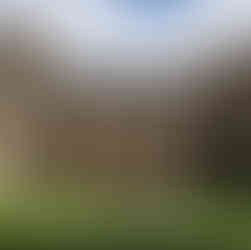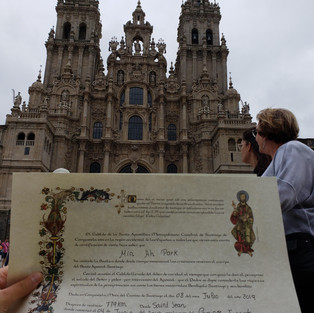A Walk (Across Spain) to Remember: My First Camino de Santiago - The French Way, 2019
- Angie Min Ah Park

- Jul 19, 2019
- 11 min read
Updated: Oct 8, 2019
In March of 2019, before booking the one-way flight to Biarritz (France), I faced these facts:
Camino Frances: approx. 780 km, a road from one northern end of Spain to the other.
The route stretches from the French Pyrenees to Santiago de Compostela, a historic city marking the end of a pilgrimage since the 9th century.
Estimated time of completion: 1 month
Average walking distance per day: 25 km / 6 - 8 hours
Estimated budget per day: 30 Euros
Requirements: backpacking, a good pair of trail runners, (probably) some walking sticks, and lots of blister patches.
After a month of deliberation, I received an email from EasyJet: "This is your official Booking Confirmation." My bank account took a hit. The dice had then left my hand.
A Summary of June On The Road
I began the Way of St. James pilgrimage from St. Jean Pied de Port in France on the 6th of June, 2019. I completed my walk on July 8th, 32 days later. My daily schedule for all the days in between, plus and minus unexpected changes and resting days, looked something like this:
5:30 - 6:30 AM: Get ready, pack, and have breakfast (if available)
6:30 - 11:30 AM: Walk
11:30 - 12:30 PM: Lunch
12:30 - 2 PM: Walk
2 - 4 PM: Unpack, grocery shop, shower, and nap (siesta!)
4 - 8 PM: Read/ write
8 - 9 PM: Dinner
9 - 10 PM: Prepare for the next day (read about the route)
10 PM: Sleep
Nearly every night, I slept in an albergue (Camino hostels) among bunkbeds full of snoring pilgrims; everyday, ate lots of Menu del Peregrino (set Pilgrim's meals), and on every road, met incredible people from all over the world, of differing ages, professions, and walks of life. And all this journey was completed while following painted yellow arrows on every step of the way -- on highway rails, rocks by the bushes, random cement walls, and so on. If this past June on the Camino was anything, it was simply and truly, a walk to remember.
What is the Camino de Santiago?

I'm glad you asked. There are many places on the web that can answer this question for you better than I can: try Spain's official pilgrim's site, Camino de Santiago, and CaminoWays, to start. If you're interested in more info after that, I recommend John Brierley's guidebooks such as A Pilgrim's Guide to the Camino de Santiago - Camino Frances (2019) and Camino Forums as the next best places to go.
History
In short, the Camino is a long-distance walk, which began as a Christian pilgrimage more than 1000 years ago since the discovery of the body of St. James (one of Jesus' 12 disciples) during the 9th century. There are many routes, all of them finishing at the tomb of St. James in Santiago de Compostela. The French Way (or the Camino Frances) is the longest and most popular of these routes, starting from St. Jean Pied de Port (a French border town to Spain), and it is also on the World Heritage list by UNESCO.
The Camino's statistics in the last 30 years have been most impressive: there has been a huge growth, encouraged religiously by Pope John Paul II's visits in 1982 and 1989, when the World Youth Day was held in Santiago, and the increase of cultural and social tourism for the Camino's sports, sight-seeing, and spiritual benefits.
Statistics
In 2018,
327,328 pilgrims received the official accreditation for Camino Frances completion (you can receive this if you walk the last 100,000 km from Sarria to Santiago de Compostela and get 2 stamps per day on your Pilgrim's Passport along the way) in comparison to 1985, when 1,245 pilgrims arrived in Santiago.
Approximately 93% of the pilgrims completed the way by foot (as opposed to bicycling, on a horse or a donkey, or other ways);
the data shows a nearly even split of approx. 50% female and 49% male pilgrims, the majority between 30 and 60 years of age (54%) and from 177 different Nationalidades.
More statistics can be found here from the official pilgrim's office, in Spanish.
What is Life on the Camino Like?
Highlights
Most simply put, walk, eat, sleep, repeat. Sprinkled with the joys of cheap beer and wine, delicious Spanish tapas, daily sightseeing (passing scenery and over 1800 historical sites on the way), siesta naps, some unexpectedly beautiful sunrises and sunsets, new languages, interesting people, and serendipitously enlightening conversations.
Let me also highlight the parts you may not initially enjoy: resilient and returning blisters, the Spanish heat (if you do your walk in the summer), a chamber choir of roaring snores, salty foods, neverending bocadillos (sandwiches) and fries without ketchup, language barriers, full albergues (happens occasionally in the summer season, which means you have to walk some kilometres more to the next town), and experiencing your body's physical and mental limits of fatigue and solitude.
I am trying my best not to overstate the experience by making it hyperbolically positive. The Camino, as beautiful and profound as it is, is also a long and arduous journey -- a motivational challenge at best and a sacrificial pilgrimage at its difficult moments.
Personally, the coolest part of the Camino was finding an arrow marking (mostly in yellow and accompanied by a sea-shell sign), everywhere I went. As someone directionally challenged, this was a relief and a novel experience. The ability to let go, of finding the "right" way, the business of "normal" life, pressures from people and work/school settings, and of your concerns at home, is one of the greatest gifts of the Camino, one that comes with a new perspective.
Here are some other aspects of life on the Camino that you may be curious about:
Lodging
On the practical side, the Camino is one unique place in the world where you don't have to worry about pre-booking your accommodations. Surprisingly, it's recommended not to. As you walk across 4 different provinces and encounter at least 33 major towns along the way, there are several villages and some large cities. I don't think it's an overstatement to say that on an average day, at least every 5km, give or take, you will run into a village/town/city. In most of these places, there are albergues (municipal, religious, or private) with anywhere between 5 and 140 beds that range from 5 Euros to approx. 15 Euros per night. Many religious albergues take donations instead of a fixed cost per night, and there are also many private accommodations (with single or double rooms, like a hotel), starting from around 30 Euros per night. Some albergues also come equipped with pools (which are welcomed luxuries on the walk), lounging areas with views, or gorgeous patios.
Extra tips: If you're interested in seeing these accommodation options, check out: Brierley's guide, Camino apps, or Booking.com (after mapping out an estimation of your plan here). Most people rely on the apps and Booking.com, if you absolutely prefer to pre-book your accommodations (anywhere from a month to a day in advance).
Food
Most albergues offer breakfast options from 3 to 5 Euros per meal, starting from 6 to 6:30 AM. You can also choose to buy some fruits or pack your own breakfast/meals the night before. For lunch and dinner, there is usually a Menu del Peregrino (Pilgrim's menu) or Menu del Dia (daily menu) offered by many restaurants on the Camino, with an average price of 10 to 12 Euros, including some bread, a 3-course meal, and a choice among water, drinks, and wine.
The set menus usually consist of spaghetti, paella, Russian salad, mixed salad, or soup as a Primero and fish, chicken, beef, or lamb (grilled or marinated) dishes with potatoes as Segundo. The desserts usually include rice pudding, slices of cake, or ice cream.
Extra tips: After the first week, I realized that you can save quite a bit of money by grocery shopping and cooking your own meals at the shared kitchens in most albergues. Groceries as well as beer and wine are fairly cheap (compared to other European countries) in Spain, and you can't get enough of their fruits (like peaches, plums, and pineapples in the summer), cured hams, and dairy products (like cheese and milk). If you choose to go simple and cheap, as many pilgrims do, you can cook yourself a plate of pasta or spaghetti for 5 Euros-ish. You can also find some Asian restaurants along the way in major cities!
Roads and Walking Conditions

You encounter all sorts of paths -- as many as 10 different types a day, according to one day that I actively counted. Some are flat, on hard concrete, many are rocky, some climb uphill (for as long as 15 kilometres on one stretch, usually followed by uneven and steep downhill), some are narrow (by the sides of highways or in patches between bushes), and some are wide, surrounded by vast fields of beauty.
If you choose to do this in the summer (between May and August), starting in late-June, the temperature averages around 25 to 30 degrees celsius during the day. You can also come across some rain showers that tend to be heavy and in short busts or that go on all day, making ponchos and waterproof covers for your bags a necessity.
Extra tips: Many choose either trail runners (light running shoes with bottom support for long-distance walking or trail hiking) or hiking boots as their walking companions. The choices vary depending on your feet and preference as well as the changing weather conditions from heat to rain. I chose trail runners, because my feet sweat easily, and I wanted to avoid the heaviness and higher chances for blisters from wearing boots. I had to let go of some additional ankle support usually provided by the hiking boots. In the end, I was happy with my choice, as I ended up with 1 blister during the whole trip (which was magnificent!) and with some sports tape and bottom support (due to flat feet), I'd survived the walk quite comfortably.
Packing, Re-packing, and Back-Packing

Packing is a daily exercise on the Camino, one that often starts your day and ends your night. I carried a 24L Osprey bag that weighed around 10 kg, which is on the smaller side by size and heavy side by weight. You are advised not to carry more than 10% of your weight for the Camino and somewhere between 5 and 10 kg for Camino Frances. The heaviness of my bag was largely due to my laptop (a Macbook Air) that I had to carry due to my school work that I completed along the way.
I also carried: 3 T-shirts, 3 pairs of pants (1 long, 1 medium, 1 short), 3 pairs of socks and undergarments, 1 Uniqulo AIRism-series hoodie, 1 wind breaker, a zip-lock bag of pills, bandages, and ointments, a blister care kit, another zip-lock bag of toiletries, a head lamp, Go-Pro camera, some electronic cords and a converter, a small journal, John Brierley's guide, a light sleeping bag, a pair of waterproof sports sandals, some extra foldable bags (that came in really handy), sunblock, and a pair of walking sticks.

Extra tip: Out of this list, what I most regretted bringing were the excess electronics/cords, medicinal items, and clothes (you can easily do with just 2 items of each clothing category); they added extra weight, and I realized that instead of carrying this weight, it's better just to pay the price in any "just-in-case" circumstances.
Everyday, when I arrived at the albergue, I took out my necessities for the day, did my laundry (of the clothes that I wore that day), and kept my bag in a locker until I re-packed everything usually right before sleep or in the next morning.
Why Did I Choose to Do the Camino?
There is a beautiful saying among pilgrims: "You don't choose the Camino. The Camino chooses you."
I understood this expression more after having completed the walk, for the first time. The question, "Why are you doing the Camino?" is one that follows you throughout the walk, asked by different people from different places, in different languages, maybe even for different reasons.
To be honest, I am not sure exactly why I decided to embark on the Camino. I struggled to answer the common question during the beginning weeks of the trip, and this gave me some hours (sometimes days) of overwhelming reflection and anxiety. In hindsight, I think this struggle is normal: you inevitably search for a reason when you are putting your body through long-term strain, like searching for the cause behind a torturous endeavour, the motivation behind a challenge, or maybe just simply, the light at the end of a tunnel.
In the months leading to March (when I booked my trip), various events and life changes had taken place. I spent months cooped up in an office reading, writing, applying, and studying: playing post-York-University-strike catch up, enduring through my first Comprehensive Exam season (a usual PhD requirement), applying for (and thankfully later receiving) various opportunities and awards, and writing never-ending research papers. This was a harder-than-usual semester with well above 60 hour weeks, coupled with volunteer activities on weekends and work (holding dual positions as a Teaching Assistant and Research Assistant). Needless to say, it was a stressful stretch of months, and on the personal side of things, I had also recently turned single and begun encountering mental health challenges due perhaps to the increased stress factors and the trauma of the strike.
I desperately needed a vacation. At the same time, I didn't just want to relax on the beach or tour all the wonders of the world - both wonderful endeavours but just not my preference at the time - I wanted an opportunity to reflect. To put a pause to my life, embrace the newly realized freedoms of being single and an extended student, and at the same time, endure through a challenge. I am also a Catholic with dwindling faith: the last few years, especially, have been a spiritual struggle. The Camino, for all these reasons, seemed perfect.
I had heard about the Camino in passing, from a friend in BC who had completed the walk, my church priest, through a few Youtube clips and Instagram pictures, a few passing words in bars, and so on. I hadn't watched the notorious Camino film, The Way, written and directed by Emilio Estevez, or the popular South Korean TV shows portraying the pilgrimage experience by celebrities. Somewhere amidst this whirl of gossip and information, I chose the Camino. Or perhaps, as I do think now, the Camino chose me.
Nevertheless, all these reasons fell through the cracks of words when asked why I was doing the Camino. Any combination of words seemed too little or too many and always inadequate. There was also a side of me wondering, until the very end, if the reasons that I had chosen to do the Camino were the "right" reasons, in other words, worth outlining and justifying, to others as well as to myself.
Hindsight 20/20: somewhere along the walk, I learned what Rosa, the first pilgrim I talked to on the bus to St. Jean Pied de Port, had meant when she'd said as a fifth-time Camino pilgrim, that "You will find your reasons later, if not at the end of the walk, then later in life." In the weeks of routine through the pain, fatigue, thinking, withdrawing, following, seeing, meeting, and talking, I hit an auto-pilot mode in my body and mind. I learned to enjoy the walk. Somewhere, somehow, all of the above patterns became my life and along the wavelengths of ups and downs, I found a note that I would encounter seldom in frequency, yet piercing enough to want more of it. I also did achieve all the so-called "goals" that I had in mind when I chose the Camino: the desperately needed vacation, the rest and meditation, self-care, and partaking in and completing a unique challenge.
I am also adamant that in the next years of my life to come, I will discover more reasons why "the Camino chose me" in 2019. The skills and experiences I have gained during the walk are ones that I can easily foresee aiding me in the future. For this reason, I am glad to have done this in my 20s with still many decades and life's waves to come.
In the near future, I hope to upload more pictures and posts about my experience on the Camino: as a PhD student, during exam season, as a struggling Catholic, a woman, solo-traveller, etc. In the meantime, I will end here, hoping that some of my words will ring the calling of the Camino in your ears. If you have any questions, feel free to ask (via email or comments), and I would be happy to answer them or at the least, point you to some more sources.
To finish, as I wish for you to hear the Spanish pilgrims say, sooner rather than later: "Buen Camino."
























































Comments